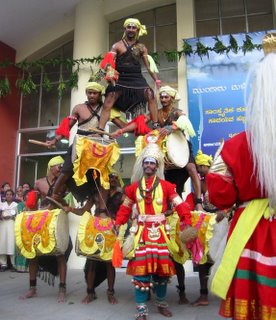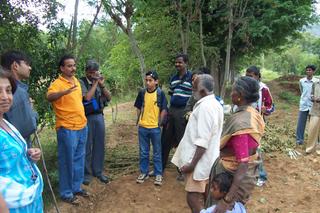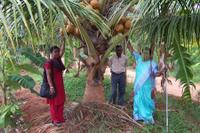Meanwhile some good news…
Record downpour- but will it be saved…

(Arkavathi River near Tavarekere is seen overflowing)
The Hindu. Wednesday, Oct 26, 2005
Arkavathi River near Tavarekere is seen over flowing due to heavy rains in the last few days. The river provides water to the Tippagondanahalli reservoir, which supplies drinking water to West Bangalore. According to the Meteorological Department, the city received 525 mm rains up to 1400 hours on Tuesday, breaking the previous record of 522 mm in 1956. All lakes in and around the city are being flooded due to heavy rains that lashed the city in the past few days.
-----------------------------
Gift a ‘Green Gift’ to loved ones
DH News Service
Bangalore: Wednesday, June 15, 2005 You can have a tree in your own name or in the name of your family, or even present some one with the ‘Green Gift’ on any special occasion (birthday, wedding anniversary) by sponsoring a sapling for Rs 500! Parisara, an NGO, jointly with the State government, has launched ‘Spoorthi Vana’. The aim is to create infrastructure to plant and grow trees in and around the catchment area of Tippagondanahalli reservoir, which supplies water to various parts of Bangalore such as Rajajinagar, Basaveshwaranagar, Malleswaram, Mahalakshmi Layout, and Vijayanagar.
Under the scheme, ‘Spoorthi Vana’ will nurture and grow trees for citizens in barren land in the reservoir area. Every tree will be numbered and a certificate will be issued to each donor, Additional Chief Secretary Vijay Gore, who is among the first to pay Rs 500, said while addressing a press conference in Bangalore on Tuesday. The Spoorthi Vana programme will be launched on June 18, he added.
Reduced rainfall, depletion of greenery around the catchment areas, increased flow of silt and pollution to the reservoir and encroachment are pushing the TG Halli reservoir to the brink of extinction, Mr Eshwar Prasad, Co-ordinator of Spoorthi Vana said. This reservoir, which was earlier catering to the drinking water needs of Bangalore now caters to just 15 per cent of the City’s needs. Saplings will be grown in nearly 300 acres of land around the T G Halli reservoir. The saplings, which are planted in ‘Spoorthi Vana’ will belong to the Government, he said. Noted personalities, including Poornachandra Tejaswi, U R Ananthamurthy, Girish Karnad, G S Shivarudrappa, have expressed their willingness to promote the concept, he said.
Those interested in participating in the programme can contact the President, ‘Spoorthi Vana’, BWSSB-Combined Jewel Filters, 18th cross, Malleswaram, Bangalore-3. Phone: 9448077019/ 9845043309 or ecolinker@hotmail.com. http://www.deccanherald.com/deccanherald/jun152005/city1959112005614.asp
Monsoon Festival
Arkavathi and Kumudvathi are two rivers originating from Nandi and Shivaganga hills, which used to play a vital role in Bangalore’s eco-system. These two merge at Tippa Gondanahalli Reservoir which was the main water source for our city before Cauvery river supply came in. But all this is history today as these two rivers are polluted and fast drying up. So a river revival committee has been formed and a Monsoon Festival is being organised to involve more people from the city into this movement.

(Visitors viewing the efforts of river revival trust)
Festivals are an inseparable part of our culture. Monsoon and festivity have always been integral part of rural life. The season’s first rain has been celebrated in poems and folk songs. Dwelling in the midst of urban concrete jungle, we need to be reminded about these joyous moments of nature.
Monsoon Festival is conceived to create revive the celebration of the onset of monsoon and also to build awareness on preserving water. An entire evening filled with exuberant display of songs and dance on water and rain is being organised on Saturday 20th August 2005.
The program will have folk songs, folk dance, dance drama, instrumental performance and even a dinner serving home-made organic food dinner! Lets mingle and share the joy at this spectacular cultural evening at Ravindra Kalakshetra.

(Dollu Kunitha and Veeragaase folk dancers)
A scintillating cultural event and organic dinner to celebrate monsoon
Monsoon Festival ‘05
Saturday 20th August 2005 5pm to 8.30pm at Ravindra Kalakshetra J C Road, Bangalore
Arkavathi-Kumudvathi Nadi Punaschetana Samithi#3, AIS Bhavan, Seshadripuram, Bangalore-20 Tel: 98440 34777, 98455 35573



